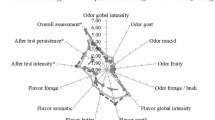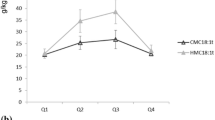Abstract
Adapting feeding system is an effective way for improving the nutritional quality of milk as currently intended by dairy industry. The objectives of this work were (1) to characterize milk from feeding systems based on herbage or corn silage with or without flaxseed and (2) to authenticate the milk from the three systems on the basis of the fatty acid (FA) profile. Bulk milk samples were collected five times on 24 farms in the West of France. Farms were classified according to three feeding systems: "Herbage" system with herbage as the only forage source; "Corn silage" system with corn silage as the main forage (33.6% of DM grass based); "Corn silage+flaxseed" system with corn silage as the main forage (24% of DM grass based) supplemented with 690 g.day−1.cow−1 of extruded flaxseed. The "Corn silage+flaxseed" system had higher milk yield and lower milk fat and protein contents. Compared to milk from “Herbage system”, milk from "Corn silage+flaxseed" system was rich in mono- and poly-unsaturated FAs, trans FAs, C18:0, isomers of C18:1 and C18:2 (respectively +13, +21, +28, +13, +44, +54 percentage units), whereas milk from the "Herbage" system was rich in odd, branched chain FAs and cis-9,trans-11-CLA (respectively +51, +55 and +15 percentage units compared to milk from "Corn silage+flaxseed" system). Milk FA composition from "Herbage" and "Corn silage" systems was more variable throughout the year than that from the "Corn silage+flaxseed" system because of the incorporation of more pasture during spring and summer. The linear discriminant analysis performed on FAs permitted to differentiate milk from each system with only 2.5% of milks misclassified, even for milk from the "Herbage" and "Corn silage+flaxseed" systems, which had a similar C18:3 content. This study showed that it is possible to characterize milk from different feeding systems and especially to differentiate one from another based on their composition of some milk FAs.



Similar content being viewed by others
Notes
The contractual conditions between farmers and the animal food industry include doubling the amount of C18:3 in the milk in comparison to a standard feeding management based on corn silage, having a ratio ω6/ω3 lower than 5 and decreasing the amount of palmitic acid in the milk.
Abbreviations
- ALA:
-
α-Linolenic acid C18:3
- AU:
-
Animal unit
- BW:
-
Body weight
- CLA:
-
Conjugated linoleic acid
- DHI:
-
National dairy herd information
- DIM:
-
Days in milk
- F:
-
Fisher’s F
- FA:
-
Fatty acid
- IC:
-
Intake capacity
- LDA:
-
Linear discriminant analysis
- NPN:
-
Non-protein nitrogen
- NCN:
-
Non-casein nitrogen
- SD:
-
Standard deviation
- SEM:
-
Standard error to the mean
- RMSE:
-
Root-mean-square error
- VFA:
-
Volatile fatty acid
References
Abrahamse PA, Dijkstra J, Vlaeminck B, Tamminga S (2008) Frequent allocation of rotationally grazed dairy cows changes grazing behavior and improves productivity. J Dairy Sci 91:2033–2045
AFNOR NF V04-210 (2000) Lait - Détermination de la teneur en matière grasse - Méthode acido-butyrométrique. Afnor, Paris, France
AFNOR NF V04-216 (2011) Lait - Détermination de la teneur en protéines vraies - Méthode au noir amido (méthode pratique). Afnor, Paris, France
Alais C (1984) Les protides du lait. La caséine et le phénomène de coagulation. P 107 in Science du lait, principe des techniques laitières, SEPAIC ed, Paris, France
Bauchart D, Duboisset F (1983) Utilisation des colonnes capillaires de verre pour l’analyse des acides gras du lait. Cah Techn INRA 1:37–46
Bauman DE, Griinari JM (2003) Nutritional regulation of milk fat synthesis. Annu Rev Nutr 23:203–227
Brûlé G, Maubois JL, Fauquant J (1974) Etude de la teneur en minéraux des produits obtenus lors de l’ultrafiltration du lait sur membrane. Lait 54:600–615
Brunschwig P, Hurtaud C, Chilliard Y, Glasser F (2010) L’apport de lin dans la ration des vaches laitières: Effets sur la production, la composition du lait et des produits laitiers, les émissions de méthane et les performances de reproduction. INRA Prod Anim 23:307–318
Caroprese M, Marzano A, Marino R, Gliatta G, Muscio A, Sevi A (2010) Flaxseed supplementation improves fatty acid profile of cow milk. J Dairy Sci 93:2580–2588
Charroin T, Capitain M, Perrot C (2004) Le coût de production du lait en France dans les exploitations spécialisées, évolution de 1990 à 2001. Renc Rech Rumin 11:189–192
Chilliard Y, Glasser F, Ferlay A, Bernard L, Rouel J, Doreau M (2007) Diet, rumen biohydrogenation and nutritional quality of cow and goat milk fat. Eur J Lipid Sci Technol 109:828–855
Chilliard Y, Martin C, Rouel J, Doreau M (2009) Milk fatty acids in dairy cows fed whole crude linseed, extruded linseed, or linseed oil, and their relationship with methane output. J Dairy Sci 92:5199–5211
Clare DA, Swaisgood HE (2000) Bioactive milk peptides: a prospectus. J Dairy Sci 83:1187–1195
C.N.I.E.L. (2013) La consommation humaine par habitant des principaux produits laitiers dans le monde. P 176 in L’économie laitière en chiffres – Edition 2013
Collomb M, Bisig W, Bütikofer U, Sieber R, Bregy M, Etter L (2008) Seasonal variation in the fatty acid composition of milk supplied to dairies in the mountain regions of Switzerland. Dairy Sci Technol 88:631–647
Collomb M, Schmid A, Sieber R, Wechsler D, Ryhänen EL (2006) Conjugated linoleic acids in milk fat: variation and physiological effects. Int Dairy J 16:1347–1361
Coppa M, Ferlay A, Monsallier F, Verdier-Metz I, Pradel P, Didienne R, Farruggia A, Montel MC, Martin B (2011) Milk fatty acid composition and cheese texture and appearance from cows fed hay or different grazing systems on upland pastures. J Dairy Sci 94:1132–1145
Coppa M, Ferlay A, Chassaing C, Agabriel C, Glasser F, Chilliard Y, Borreani G, Barcarolo R, Baars T, Kusche D, Harstad OM, Verbič J, Golecský J, Martin B (2013) Prediction of bulk milk fatty acid composition based on farming practices collected through on-farm surveys. J Dairy Sci 96:4197–4211
Coulon JB, Rémond B (1991) Variations in milk output and milk protein content in response to the level of energy supply to the dairy cow. A review. Livest Prod Sci 29:31–47
Couvreur S, Hurtaud C, Lopez C, Delaby L, Peyraud JL (2006) The linear relationship between the proportion of fresh grass in the cow diet, milk fatty acid composition, and butter properties. J Dairy Sci 89:1956–1969
Delaby L, Faverdin P, Michel G, Disenhaus C, Peyraud JL (2009) Effect of different feeding strategies on lactation performance of Holstein and Normande dairy cows. Animal 3:891–905
Dhiman TR, Anand GR, Satter LD, Pariza MW (1999) Conjugated linoleic acid content of milk from cows fed different diets. J Dairy Sci 82:2146–2156
Doreau M, Poncet C (2000) Ruminal biohydrogenation of fatty acids originating from fresh or preserved grass. Reprod Nutr Dev 40:201
Ferlay A, Martin B, Pradel P, Coulon JB, Chilliard Y (2006) Influence of grass-based diets on milk fatty acid composition and milk lipolytic system in Tarentaise and Montbéliarde cow breeds. J Dairy Sci 89:4026–4404
Heck JML, van Valenberg HJF, Dijkstra J, van Hooijdonk ACM (2009) Seasonal variation in the Dutch bovine raw milk composition. J Dairy Sci 92:4745–4755
Hurtaud C, Agabriel C, Dutreuil M, Rouillé B (2010a) Caractérisation de la composition des laits selon les pratiques d’alimentation dans les principales régions laitières françaises. Renc Rech Rumin 17:381–384
Hurtaud C, Faucon F, Couvreur S, Peyraud JL (2010b) Linear relationship between increasing amounts of extruded linseed in dairy cow diet and milk fatty acid composition and butter properties. J Dairy Sci 93:1429–1443
Institut National de la Recherche Agronomique (INRA) (2007) Alimentation des bovins, ovins et caprins. Besoin des animaux – Valeur des aliments. Tables INRA 2007, ed. Quae, INRA, Versailles, France.
Legrand P (2010) Intérêt nutritionnel des acides gras saturés. Sci Aliment 29:115–122
Leiber F, Kreuzer M, Wettstein HR, Scheeder MRL (2005) A study on the causes for elevated n-3 fatty acids in cows’ milk of Alpine origin. Lipids 40:191–202
Martin B, Hurtaud C, Graulet B, Ferlay A, Chilliard Y, Coulon JB (2009) Herbe et qualité nutritionnelle et organoleptique des produits laitiers. Fourrages 199:291–310
NF ISO 26462/FIL 214 (2010) Lait - Détermination de la teneur en lactose - Méthode enzymatique par pH-métrie différentielle. Fil, Paris, France
Nicolis RJ (1997) Dietary fat saturation effects on low-density-lipoprotein concentration and metabolism in various animal models. Am J Clin Nutr 65:597–610
Sanchez WK, McGuire MA, Beede DK (1994) Macromineral nutrition by heat stress interactions in dairy cattle. J Dairy Sci 77:2051–2079
SAS (2005) Sas Institute Inc., Cary, NC, USA
Schori F, Fragnière C, Schaeren W, Stoll W (2006) Graines de lin et de tournesol dans l’alimentation de la vache laitière. Rev Suisse Agric 38:25–30
Siri-Tarino P, Sun Q, Hu FB, Krauss MK (2010) Meta-analysis of prospective cohort studies evaluating the association of saturated fat with cardiovascular disease. Am J Clin Nutr 91:535–546
Vlaeminck B, Fievez V, Van Laar H, Demeyer D (2004) Prediction of rumen volatile fatty acid proportions produced in vitro using variations in rumen odd and branched chain fatty acids. J Anim Physiol Anim Nutr 88:401–411
Vlaeminck B, Fievez V, Cabrita ARJ, Fonseca AJM, Dewhurst RJ (2006a) Factors affecting odd- and branched-chain fatty acids in milk: a review. Anim Feed Sci Technol 131:389–417
Vlaeminck B, Fievez V, Tamminga S, Dewhurst RJ, Van Vuuren A, De Brabander D, Demeyer D (2006b) Milk odd- and branched-chain fatty acids in relation to the rumen fermentation pattern. J Dairy Sci 89:3954–3964
Vlaeminck B, Abrahamse PA, Fievez V, Lourenco M, Dijkstra J, Tamminga S (2010) The effect of allocation frequency in rotational grazing systems on the fatty acid profile in milk fat of dairy cows. Pages 586–588 in Grassland in a changing world. Proc. 23rd General Meeting of the European Grassland Federation, Kiel, Germany
Williams CM (2000) Dietary fatty acids and human health. Ann Zootech 49:165–180
Acknowledgments
This research was supported in part by the European TRUEFOOD program (Traditional United Europe Food), an integrated project funded by the European Commission under the 6th Framework Program for RTD (Contract No. FOODCT-2006-016264). We thank all of the farmers from Ille et Vilaine department (France) who collaborated in the surveys. We also thank N. Huchet, T. Le Mouël and M. Vérité for their technical assistance. This work was carried out under the partnership between INRA and the “Institut de l’Elevage” within the UMT RIEL.
Author information
Authors and Affiliations
Corresponding author
About this article
Cite this article
Hurtaud, C., Dutreuil, M., Coppa, M. et al. Characterization of milk from feeding systems based on herbage or corn silage with or without flaxseed and authentication through fatty acid profile. Dairy Sci. & Technol. 94, 103–123 (2014). https://doi.org/10.1007/s13594-013-0147-0
Received:
Revised:
Accepted:
Published:
Issue Date:
DOI: https://doi.org/10.1007/s13594-013-0147-0




